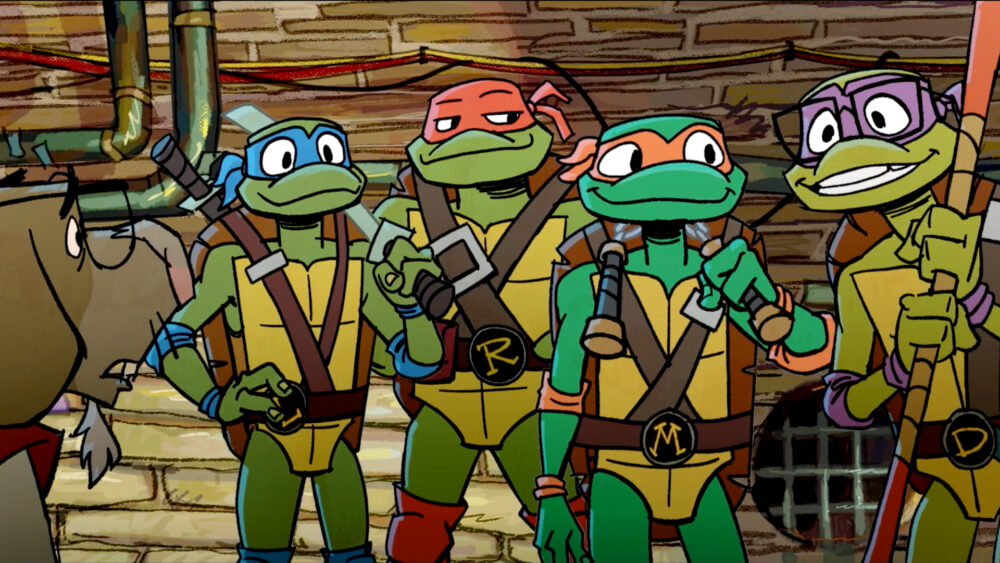The new sci-fi short SEAM by Master Key Films packs a lot of action into its 20:45 run time. Set in a near future world where humanoid machines live among us, its opening minutes track the history of the robots rebellion, the subsequent war that happens and finally the fragile peace that is established in its aftermath.
It’s a classic sci-fi setup, one you’ll be familiar with if you’ve ever seen a little film called Terminator or a show called Battlestar Galactica. In SEAM, the machines, which look just like humans based on their physical appearance, become unwitting suicide bombers when their “synthetics begin spontaneously exploding” (according to the film’s Youtube page-the science of what is happening is never really explained). An opening scene shows what we assume is a family-all of them distraught as the woman and child leave the man behind, only to see him burst into flames against his will , killing dozens of innocent bystanders a few minutes later. With that, the link between human life and these machines – integral, but also tenuous and possibly deadly-is firmly established.
In the story that follows, the setting is easily recognizable to anyone following current geopolitical crisis. A militarized border zone (called “the seam”, where the film gets its name) surrounds a desert territory that has been set aside for the machines and is reminiscent of similar war-torn areas around the world. A crowded bazaar, women wearing headscarves and traditional music all nod to the Middle East. By using such parallels, the filmmakers surely wanted viewers to see a comparison between this fictional dystopia and the conflicts that exist in our real world, where wars are fought and borders are drawn based on religious and ethnic differences rather than that between man and machine.
SEAM‘s last 10 minutes are heavy on chases, explosions and hand to hand combat. While some of the effects work better than others, what kept me watching was the human connection. At the center of all the action is another couple (this time she’s the machine) trying to make their way unnoticed into the safe zone while being hunted by a human military force. Their emotional connection and concern for each other becomes the crux of the film. The story’s progression doesn’t always make complete sense – if she’s just trying to go back to where the robots are allowed to live, why don’t they let her? Are human-machine couples what’s prohibited? Why does becoming emotional make the machines explode any way? But the pace of the plot is enough to keep you wondering what’s going to happen next.
With visuals inspired by sci-fi cannon like Blade Runner and Mad Max, SEAM is able do a good amount of world building in relatively short time. Rather than relying on exposition, it throws you into a story that has both exciting and tender moments. Those moments add up to the question writers and filmmakers have posed for decades if not longer – what does it mean to be human after all.

Events
Paramount+ Reveals Official Main Title Sequence for the Upcoming Series TALES OF THE TEENAGE MUTANT NINJA TURTLES

During the TALES OF THE TEENAGE MUTANT NINJA TURTLES panel earlier today at San Diego Comic Con, Paramount+ revealed the official main title sequence for the series. The sequence is composed by EMMY® nominee, Matt Mahaffey, known for his work on Sanjay and Craig, Rise of the Teenage Mutant Ninja Turtles, and Rise of the Teenage Mutant Ninja Turtles: The Movie and much more.
From the studios of the Mutant Mayhem film, the all-new Paramount+ original series TALES OF THE TEENAGE MUTANT NINJA TURTLES explores the adventures of everyone’s favorite pizza-loving heroes as they emerge from the sewers onto the streets of NYC. Leo, Raph, Donnie and Mikey are faced with new threats and team up with old allies to survive both teenage life and villains lurking in the shadows of the Big Apple. The series is produced by Nickelodeon Animation and Point Grey Pictures.
TALES OF THE TEENAGE MUTANT NINJA TURTLES is executive produced by Chris Yost (The Mandalorian, Thor: Ragnarok) and Alan Wan (Blue Eye Samurai, Rise of the Teenage Mutant Ninja Turtles, Teenage Mutant Ninja Turtles [2012 Series]). Production is overseen for Nickelodeon by Claudia Spinelli, Senior Vice President, TV Series Animation, Nickelodeon, and Nikki Price, Director of Development and Executive in Charge of Production.
In addition to the upcoming new series, stream all things Turtles on Paramount+.
Events
Comic-Con 2024: Those About to Die Activation
Events
DISNEY+ CASTS DANIEL DIEMER AS FAN-FAVORITE ‘TYSON’IN SEASON TWO OF “PERCY JACKSON AND THE OLYMPIANS”

in Hall H at San Diego Comic-Con, Rick Riordan and Disney+ revealed that Daniel Diemer (“Under the Bridge”) will star as fan-favorite cyclops “Tyson” in the epic adventure series “Percy Jackson and the Olympians.” Diemer joins Walker Scobell (Percy Jackson), Leah Sava Jeffries (Annabeth Chase) and Aryan Simhadri (Grover Underwood) as a series regular. The Disney+ Original series from Disney Branded Television and 20th Television will start filming its second season next week in Vancouver.
Season two of “Percy Jackson and the Olympians” is based on the second installment of Disney Hyperion’s best-selling book series titled “The Sea of Monsters” by award-winning author Rick Riordan. In the new season, Percy Jackson returns to Camp Half-Blood one year later to find his world turned upside down. His friendship with Annabeth is changing, he learns he has a cyclops for a brother, Grover has gone missing, and camp is under siege from the forces of Kronos. Percy’s journey to set things right will take him off the map and into the deadly Sea of Monsters, where a secret fate awaits the son of Poseidon.
Diemer stars as Tyson – a young Cyclops who grew up all alone on the streets, and finds it difficult to survive in the human world. Shy and awkward, with a heart almost as big as he is, Tyson soon discovers that Poseidon is his father, which means Percy Jackson is his half-brother… and that Tyson may have finally found a home.
Diemer recently starred in the Hulu limited series “Under the Bridge” based off the critically acclaimed book of the same name and a tragic true story of a missing teen girl in Vancouver in 1997. He will next star in the indie “Thug” opposite Liam Neeson and Ron Perlman for director Hans Petter Moland. Daniel was recently seen as the lead in the indie “Supercell” opposite Alec Baldwin and Skeet Ulrich and the lead in the film “Little Brother” opposite Phil Ettinger and JK Simmons. Daniel can also be seen in the Netflix series “The Midnight Club” and recently starred as the male lead in the breakout hit Netflix feature “The Half Of It” from producer Anthony Bregman and director Alice Wu. He is a graduate of Victoria Academy of Dramatic Arts in Vancouver.
Created by Rick Riordan and Jonathan E. Steinberg, season two of “Percy Jackson and the Olympians” is executive produced by Steinberg and Dan Shotz alongside Rick Riordan, Rebecca Riordan, Craig Silverstein, The Gotham Group’s Ellen Goldsmith-Vein, Bert Salke, The Gotham Group’s Jeremy Bell and D.J. Goldberg, James Bobin, Jim Rowe, Albert Kim, Jason Ensler and Sarah Watson.
The first season of “Percy Jackson and the Olympians” is available on Disney+
-

 Interviews1 day ago
Interviews1 day agoInterview With Heroes & Villains Creative Director Doug Johnson
-

 Streaming1 day ago
Streaming1 day agoApple TV+ announces season two for delightful kids and family series “Camp Snoopy
-

 Events1 day ago
Events1 day agoThat’s My E Coverage Of The Adult Swim’s Pirate Parrrty
-

 Events9 hours ago
Events9 hours agoParamount+ Reveals Official Main Title Sequence for the Upcoming Series TALES OF THE TEENAGE MUTANT NINJA TURTLES
-

 Interviews13 hours ago
Interviews13 hours agoComic-Con 2024: Will Wight’s Cradle
-

 Events12 hours ago
Events12 hours agoDISNEY+ CASTS DANIEL DIEMER AS FAN-FAVORITE ‘TYSON’IN SEASON TWO OF “PERCY JACKSON AND THE OLYMPIANS”
-

 Events12 hours ago
Events12 hours agoComic-Con 2024: Those About to Die Activation


